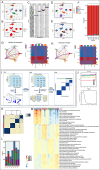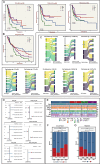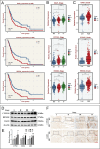Pathway-based cancer transcriptome deciphers a high-resolution intrinsic heterogeneity within bladder cancer classification
- PMID: 40528211
- PMCID: PMC12175387
- DOI: 10.1186/s12967-025-06682-1
Pathway-based cancer transcriptome deciphers a high-resolution intrinsic heterogeneity within bladder cancer classification
Abstract
Background: The heterogeneity of bladder cancer (BLCA) is affected by its inherent transcriptional properties and tumor microenvironment (TME). Stromal transcriptional components in the TME significantly influence the transcriptional classification of BLCA, and the intrinsic biological transcriptional characteristics of cancer cells may be obscured by the dominant, lineage-dependent transcriptional components of stromal origin. This study aimed to explore the degree and mechanisms by which cancer-intrinsic gene expression profiles contribute to the classification and prognosis of BLCA patients.
Materials and methods: In this study, BLCA single-cell transcriptome data from GSE135337 were used to identify pure tumor cells in BLCA and explore the different intrinsic heterogeneous cell subgroups of BLCA through pathway-based cancer transcriptome classification. Additionally, BLCA intrinsic subtypes were uncovered in the TCGA BLCA dataset based on the characteristic genes of the subgroups. Lastly, various machine learning algorithms were applied to identify novel potential targets of BLCA, following which their pro-tumorigenic effects were experimentally verified.
Results: Four BLCA intrinsic subtypes with different molecular, functional and phenotypic characteristics were successfully identified. Specifically, MA and DP subtypes demonstrated malignant phenotypes, accompanied by unfavorable clinical prognoses, limited involvement in cell death pathways, marked cell proliferation, and diminished immune activation. Notably, MA subtype exhibited the most favorable response to immunotherapy, potentially attributable to its distinctive tumor immune microenvironment. DSM subtype represented an immune-rich subtype with the optimal prognosis, characterized by abundant immune cells, high levels of co-stimulatory, co-inhibitory, major histocompatibility complex molecules, and a potential for immunotherapy response. On the other hand, HM subtype was associated with a high level of autophagy and necrosis and an "immune-hot" TIME. Furthermore, BLCA intrinsic subtypes effectively classified independent sets of BLCAs, with limited overlap with existing transcriptional classifications and showcasing unprecedented predictive and prognostic value. Finally, the DP subtype, associated with the worst prognosis, was further analyzed, leading to the identification of three potential target genes (DAD1, CYP1B1, and REXO2) significantly associated with metabolic disorders, as well as BLCA stage and grade.
Conclusion: This study identified a promising platform for understanding intrinsic tumor heterogeneity, which could offer new insights into the intricate molecular mechanisms of BLCA. Targeted therapy against BEXO2 may improve the prognosis of BLCA patients by regulating mitochondria-related metabolic disorders.
Keywords: Bladder cancer; Immune microenvironment; Intrinsic heterogeneity; Metabolic disorder; Molecular subtypes; Single-cell RNA-seq.
© 2025. The Author(s).
Conflict of interest statement
Declarations. Ethics approval and consent to participate: All human samples procedures were approved by the Ethics Committee of Zhengzhou University’s First Affiliated Hospital (2024-KY-1687). Consent for publication: All Authors have seen and approved the manuscript and consent publication. Competing interests: The authors declare that they have no competing interests.
Figures







Similar articles
-
Taurine-mediated metabolic immune crosstalk indicates and promotes immunosuppression with anti-PD-1 resistance in bladder cancer.Front Immunol. 2025 Jun 24;16:1618439. doi: 10.3389/fimmu.2025.1618439. eCollection 2025. Front Immunol. 2025. PMID: 40630945 Free PMC article.
-
Molecular feature-based classification of retroperitoneal liposarcoma: a prospective cohort study.Elife. 2025 May 23;14:RP100887. doi: 10.7554/eLife.100887. Elife. 2025. PMID: 40407808 Free PMC article.
-
Risk Score Model of Aging-Related Genes for Bladder Cancer and Its Application in Clinical Prognosis.JCO Clin Cancer Inform. 2025 Aug;9:e2500019. doi: 10.1200/CCI-25-00019. Epub 2025 Aug 8. JCO Clin Cancer Inform. 2025. PMID: 40779729 Free PMC article.
-
A meta-analysis of genome-wide association studies to identify candidate genes associated with feed efficiency traits in pigs.J Anim Sci. 2025 Jan 4;103:skaf010. doi: 10.1093/jas/skaf010. J Anim Sci. 2025. PMID: 39847436 Free PMC article.
-
Assessing the comparative effects of interventions in COPD: a tutorial on network meta-analysis for clinicians.Respir Res. 2024 Dec 21;25(1):438. doi: 10.1186/s12931-024-03056-x. Respir Res. 2024. PMID: 39709425 Free PMC article. Review.
References
MeSH terms
Grants and funding
LinkOut - more resources
Full Text Sources
Medical

